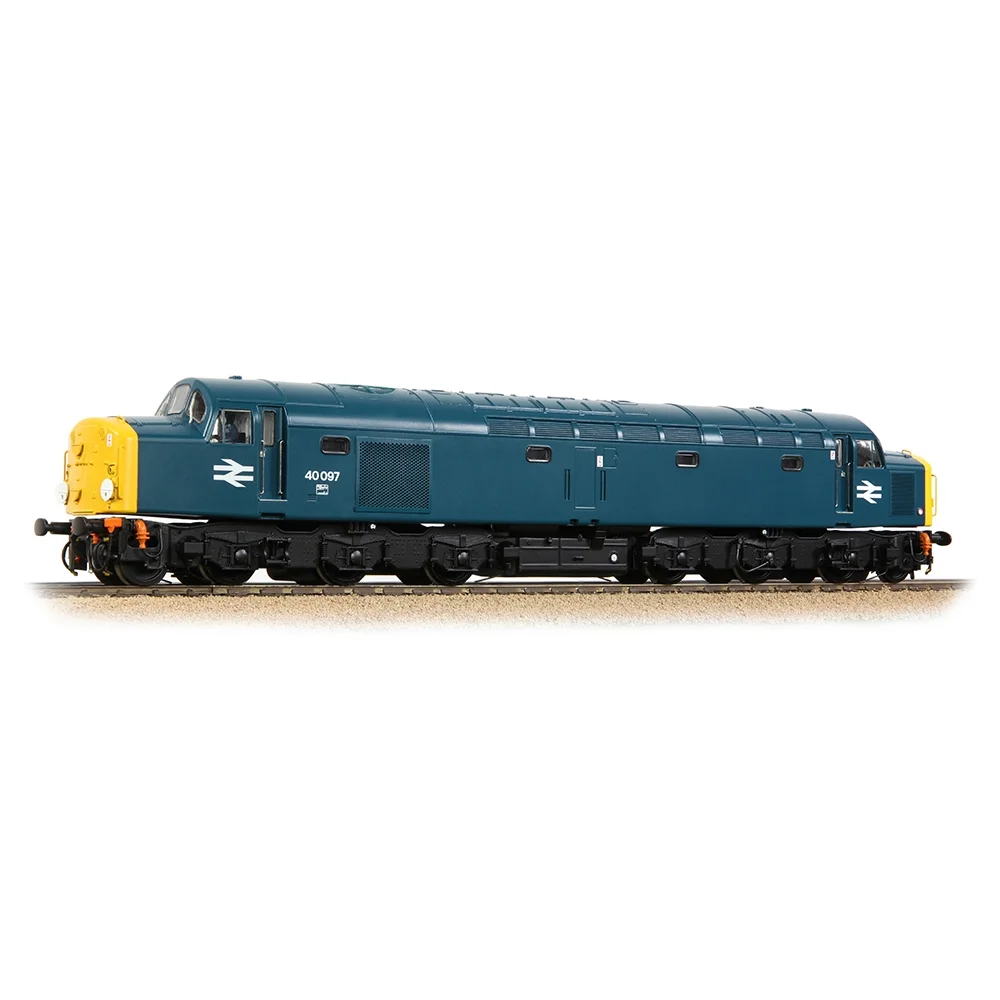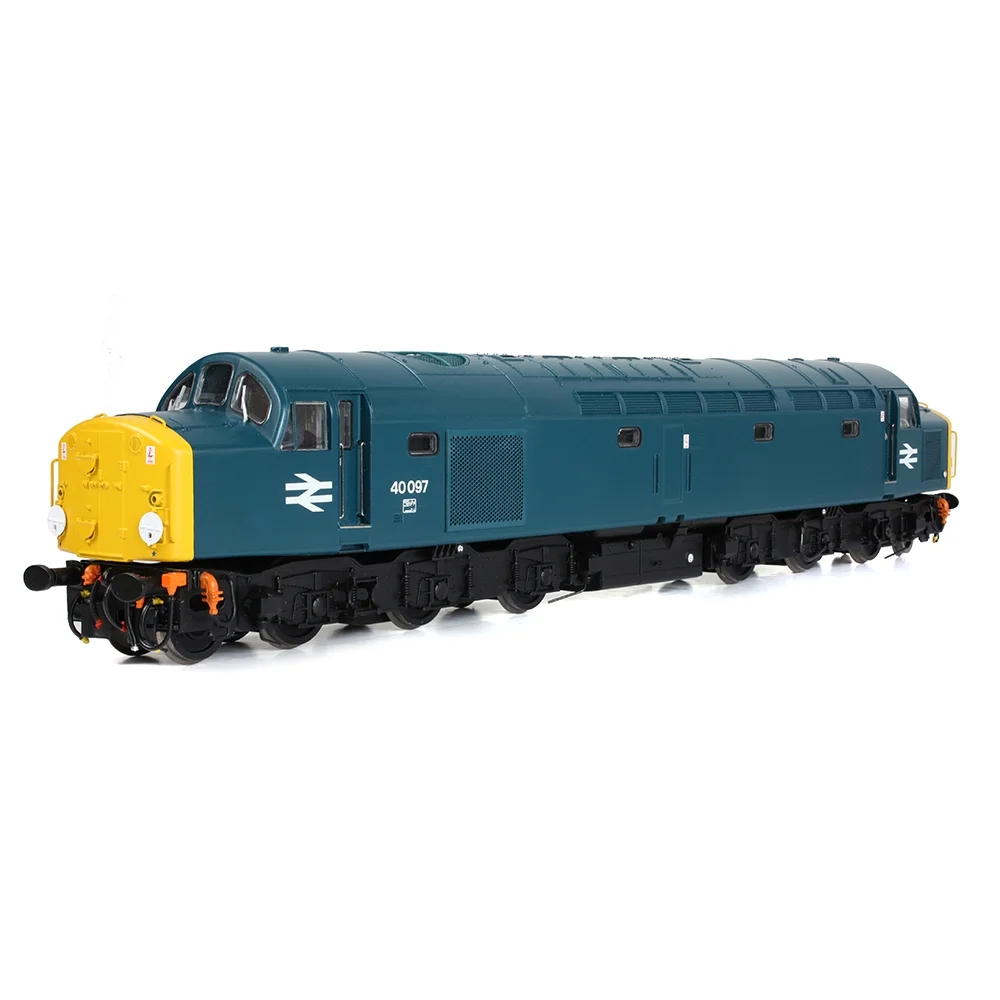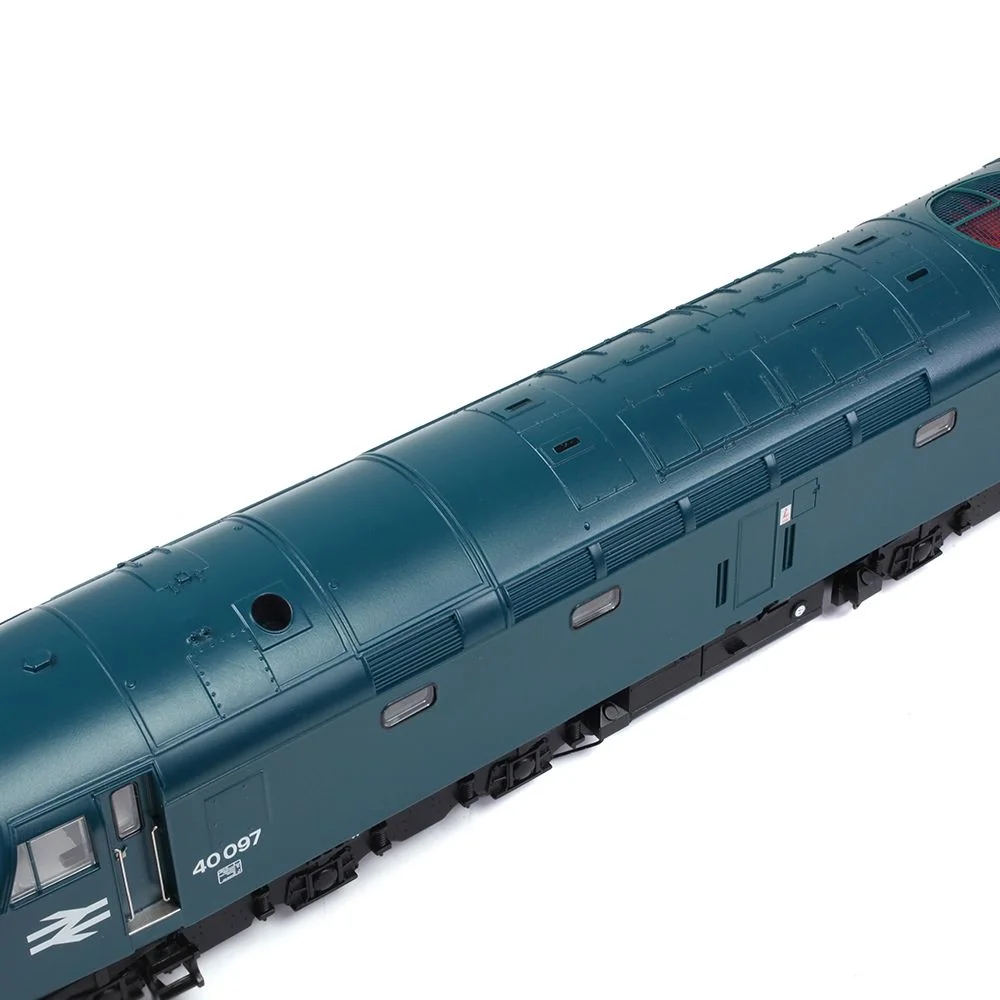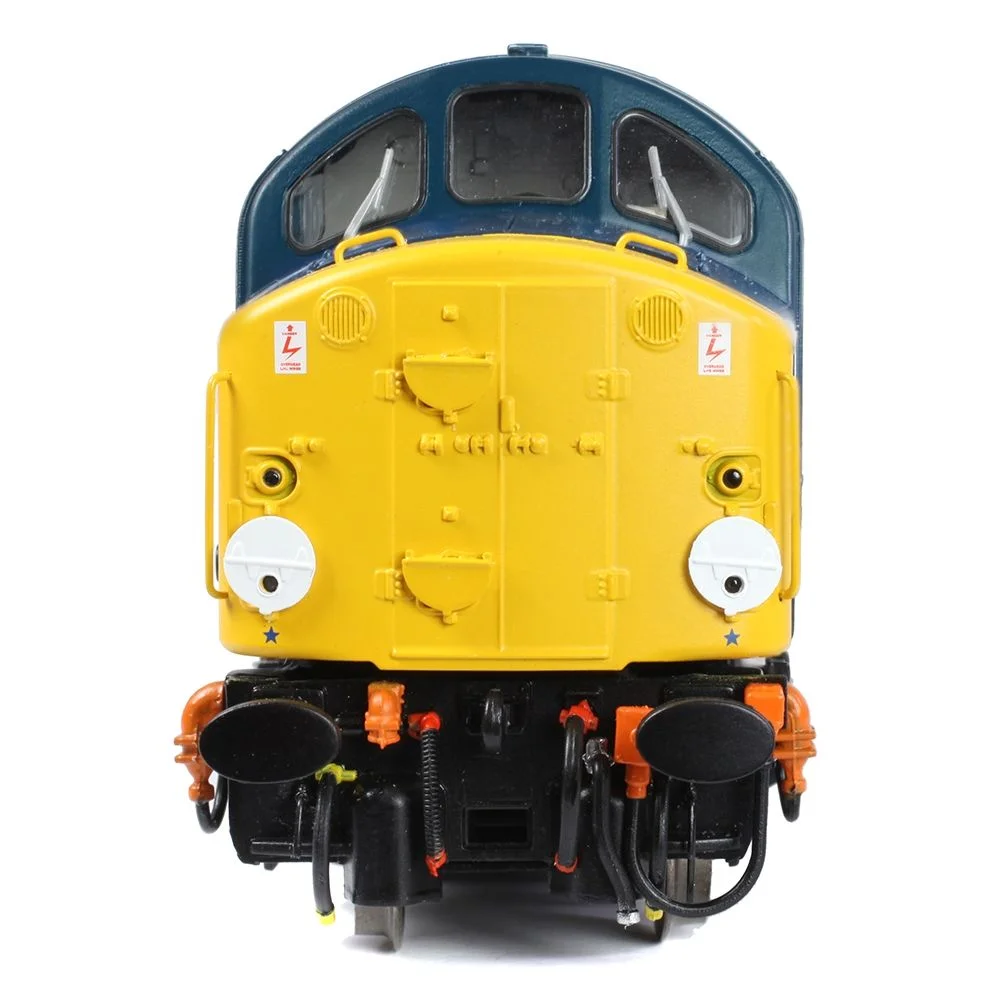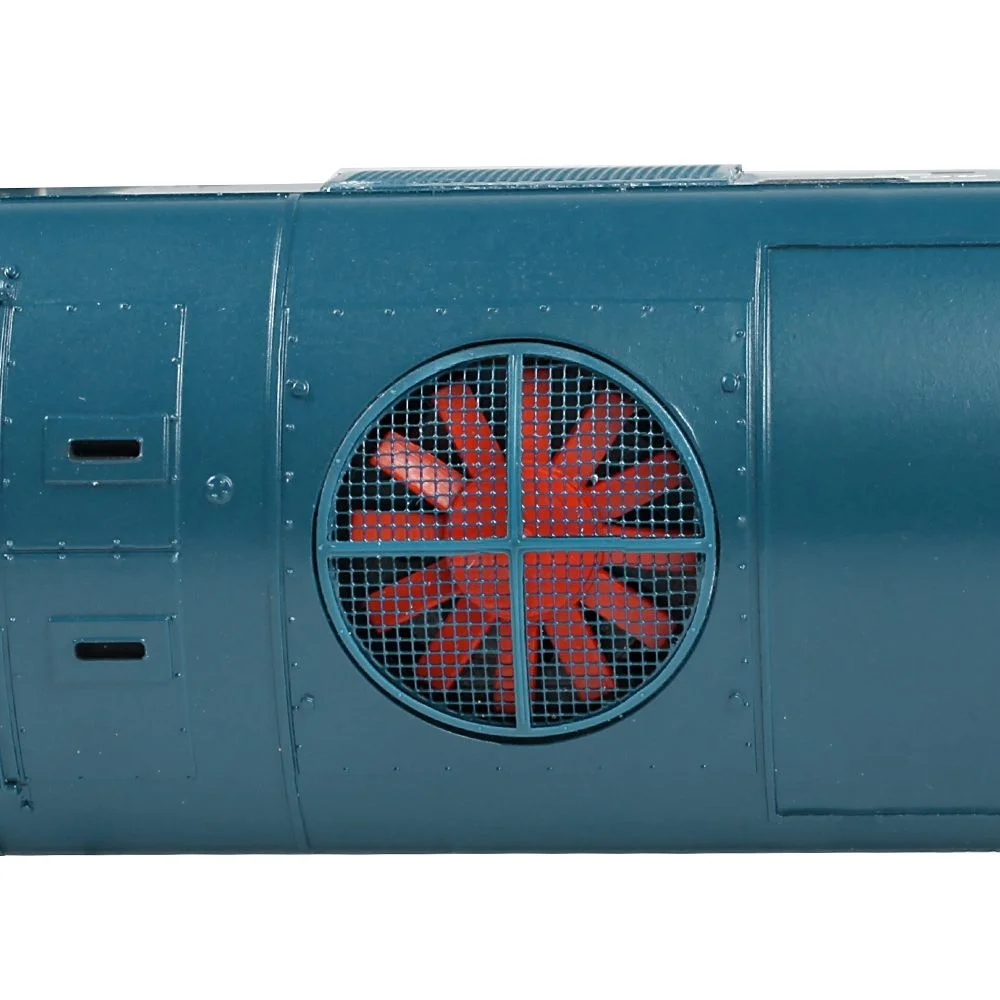Bachmann 32-489
British Rail Class 40 40097 British Rail Blue
Tooling
In 2023, Bachmann launched a comprehensive upgrade of its OO gauge British Rail Class 40 model, introducing new tooling and advanced electronics to meet modern expectations for realism and digital control. This release built upon previous iterations with significant improvements in detailing, lighting, and sound, reaffirming the Class 40’s status as a flagship diesel model in the Branchline range.
Tooling Features
- Scale: OO gauge (1:76).
- Construction: Plastic bodyshell with extensive separately fitted details; diecast chassis for strength and weight.
- Detailing: Etched fan grilles, rotating radiator fan (non-powered), fine handrails, lamp irons, sandpipes, and bufferbeam pipework pre-fitted. Sprung buffers and fully detailed cab interiors with a pre-fitted driver in one cab. Variations in nose handrails, boiler fittings, and headcode styles accurately reproduced.
- Couplings: NEM362 pockets with tension-lock couplers.
Mechanical & Electrical
- Motor & Drive: Five-pole, twin-shaft motor with twin flywheels driving all six axles via authentic 1Co-Co1 arrangement.
- Pickups: Electrical pickup from all twelve driving wheels; separate metal bearings on driven axles for smooth running.
- Minimum Radius: Second radius curves (approx. 438mm).
- Lighting: Directional headlights and tail lights, high-intensity headlights where applicable, and cab lighting. All lighting functions are independently switchable under DCC.
- Weighting: Substantial diecast chassis for excellent traction and haulage.
DCC Capability
DCC Ready with a PluX22 socket. All models include twin speaker provision, and SOUND FITTED versions feature ESU LokSound V5 decoders with exclusive sound profiles recorded from real locomotives. Sound-fitted models operate on both DCC and analogue layouts, playing authentic start-up and running sounds when power is applied.
Liveries Produced
- BR Green (early and late crest, variations with small yellow panels and full yellow ends).
- BR Blue (standard and Scottish Region variants with centre headcode boxes).
- Preservation-era schemes, including BR large logo blue (e.g., 40145).
Headcode options include disc headcodes, split boxes, and centre headcode panels, with tooling variations for Scottish Region locomotives.
Reviews & Commentary
The 2023 upgrade received strong praise for its enhanced detailing, refined tooling, and advanced electronics. Reviewers highlighted the improved lighting functions, twin speaker setup, and smooth, powerful performance. The ESU sound implementation was generally well-regarded, though some enthusiasts suggested aftermarket sound profiles for greater authenticity. Overall, the model was considered a benchmark for British diesel modelling in the 2020s.
Media & Social Media
Coverage in Hornby Magazine, Key Model World, and YouTube reviews showcased the model’s features and sound capabilities. Social media discussions praised the upgrade for its accuracy and operational quality, with some debate around sound file preferences and speaker upgrades.
Interesting Notes
This tooling introduced PluX22 connectivity, advanced lighting control, and factory-fitted sound options as standard for many variants. It remains the most feature-rich Class 40 model produced by Bachmann to date.
Bachmann's Description & Specifications
The Class 40 Diesel Locomotive has long been a highlight of the Bachmann Branchline OO scale fleet, and for 2023 this popular model has been upgraded to bring you more features than ever before.
With the DCC decoder interface upgraded to Plux22; new lighting features and enhanced speaker arrangements have also been employed on the Class 40 to enhance the operating experience. On track the model has a mighty presence, just like the real locomotives and, with its five pole, twin flywheel motor powering all six driving wheels, you can be sure of a performance to match too. This Class 40’s good looks are enriched by the superb livery application using true-to-prototype colours, fonts and logos to produce a model fit for any collection.
Finished in BR Blue livery with Disc Headcodes, we are pleased to present No. 40097.
- Bachmann Branchline OO Scale
- Era 7
- Pristine BR Blue livery
- Running No. 40097
- Equipped with a Plux22 DCC Decoder Socket – recommended Decoder item No. 36-570A
- Length 285mm
DETAIL VARIATIONS SPECIFIC TO THIS MODEL
- Disc Headcodes (Discs supplied in the Accessory Pack)
- Nose-Top Handrails
- Nose-Corner Handrails
- Clayton Boiler Port on Roof (with optional blank supplied in the Accessory Pack)
- Cantrail Grilles Arranged as appropriate to a locomotive with a Clayton Boiler
- Square Boiler Access Panel
- Fitted with Multiple Working Equipment
- Fitted with Dual Brakes (Air Pipes fitted)
- Etched Frost Grilles (optional part supplied in the Accessory Pack)
BACHMANN BRANCHLINE CLASS 40 SPECIFICATION
MECHANISM:
- Five pole, twin shaft motor with two flywheels providing drive to both bogies
- Authentic 1Co-Co1 drive arrangement with six axle drive
- Electrical pickup from all twelve driving wheels
- Separate metal bearings fitted to each driven axle
- Gearing arranged for prototypical running speeds and haulage capabilities
- 16.5mm (OO gauge) wheels to NEM310 & NEM311 standards with authentic profile and detailing
- NEM coupling pockets to NEM362 standards integrated into each bogie
- Designed to operate on curves of second radius (438mm) or greater
DETAILING:
- Bogies fitted with separate steps and sandboxes
- Rotating radiator fan (un-motorised)
- Separately applied metal detail parts, including grab handles, sand pipes and etched fan grilles
- Sprung buffers
- Pre-fitted driver in one cab
- Each model is pre-fitted with a full set of decorated, model-specific buffer beam pipework and accessory parts
LIGHTING:
- Directional lighting, including headlights and high intensity headlights where applicable, switchable on/off at either end on DCC or Analogue control
- Cab lighting*, assigned to two DCC functions for separate switching of each
- Authentic light colours and temperatures selected for each model based on era and application
DCC:
- Plux22 DCC decoder interface
SOUND:
- Two quality speakers employed for optimum sound reproduction, fitted to every model as standard
- ESU Loksound V5DCC Sound Decoder fitted to SOUND FITTED versions
- Sound files produced specifically for the Bachmann Branchline Class 40 using recordings from real locomotives
- SOUND FITTED models operate on DCC and Analogue control as supplied. On Analogue, an authentic engine start up sequence and running sounds are produced when power is applied
LIVERY APPLICATION:
- Authentic liveries applied to all models
- Multiple paint applications employed on each model using BR and corporate specification colours
- Logos, numerals and text added as appropriate using multi-stage tampo printing using authentic typefaces, logos and colours
- In addition, where applicable Etched Nameplates and Plaques are also provided
Class & Prototype
- Class: British Rail Class 40
- Traction: Diesel
- Transmission: Electric
- Built: 1958-1962
- Total Built: 200
- Running Number: 40097
British Rail Class 40 "Whistlers" were iconic diesel-electric locomotives that pioneered Britain's transition from steam to diesel traction between 1958-1985. Built by English Electric with distinctive turbocharger whistles and 2000hp engines, these 200 locomotives initially worked prestigious services like the Flying Scotsman before settling into secondary passenger and freight duties. Their conservative engineering prioritized reliability over power, leading to eventual displacement by more capable designs. Seven locomotives survive in preservation, while excellent model representations from Bachmann, Graham Farish, and Heljan serve railway modellers across all scales. The class remains beloved for its pioneering role, distinctive sound, and elegant styling that defined the early diesel era.
Operator & Livery
- Operator: British Rail
- Livery: Blue
- Era: 7 - British Rail Blue TOPS
British Rail (1965-1997) transformed Britain's railways through revolutionary modernisation, introducing the iconic double arrow logo, Rail Blue livery, and business sectorisation. BR pioneered high-speed rail with the InterCity 125 and Advanced Passenger Train, electrified major routes, and created profitable divisions like InterCity and Network SouthEast. From steam succession through diesel and electric development to privatisation preparation, British Rail's diverse locomotive fleet, multiple livery schemes, and operational scenarios provide unparalleled variety for railway modellers across all scales and periods.
BR Blue, also known as Rail Blue or Monastral Blue, was introduced in 1965 as part of British Rail's comprehensive corporate identity overhaul that accompanied the rebranding from British Railways to British Rail. The colour was officially defined by British Standards BR28/6001 (airless spray finish) and BR28/5321 (brush finish), representing a dark, greyish blue tone specifically chosen to hide dirt and weathering effects well.
The livery was prototyped on the experimental XP64 train in 1964 before becoming the standard scheme from 1 January 1965. Rail Blue was applied to all diesel and electric locomotives with yellow warning panels (initially small, then extending to full yellow ends from 1966). The standardised application included the iconic double arrow logo and Rail Alphabet typeface, creating one of the most successful transport corporate identities of the 20th century.
The livery dominated British Rail operations for over two decades until sectorisation in the 1980s began fragmenting the unified appearance. Despite initial colour fading problems in early applications, these were resolved by the late 1970s when the Large Logo variant was introduced featuring extended yellow areas and full-height double arrow symbols. Rail Blue's enduring appeal among railway enthusiasts reflects its role as the definitive British Rail image during the organisation's most unified period.
